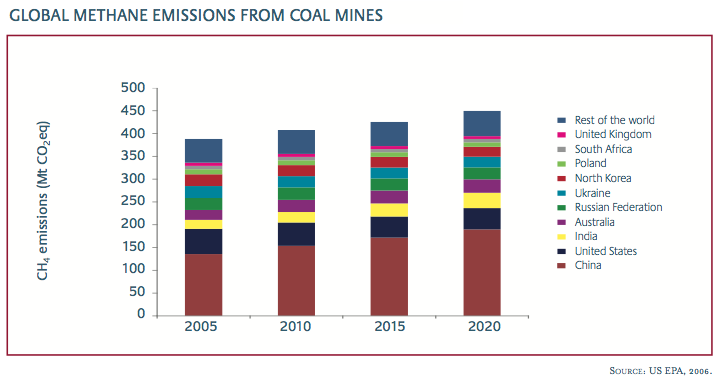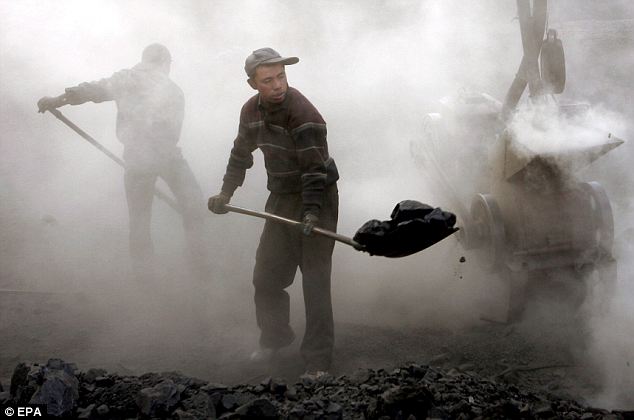On Saturday an explosion killed 7 coal miners in China’s Guizhou Province; another in a long history of fatal coal mining accidents in China. Explosions like this are typically caused by the release of highly volatile, low-concentration methane. During coal extraction, Coal Mine Methane (CMM), which is trapped in the coal seam, is released into the air supply.
CMM emissions can be avoided through several different drainage processes. Drainage, or degasification, of coal mines can occur pre- or post-mining. Degasification drains methane from the coal seam, through the use of boreholes, or methane can be collected from “gob,” or coal debris. Gob gas is typically removed from mines through ventilation systems.
Generally, CMM is classified into four concentrations:
- High-Concentration CMM is 80% methane or more.
- Medium-Concentration CMM is between 30-80% methane.
- Low-Concentration CMM is less than 30% methane.
- Ventilation Air Methane (VAM) is released from mine ventilation shafts as air with a highly diluted (<1%) concentration of methane.
Most of China’s CMM is released in the form of VAM and more than 70% of recovered CMM is low-concentration. At lower concentrations CMM becomes much more volatile, with an explosive range between 5-15%, though, as the IEA notes, anything under 30% is considered dangerous.
China has several policies in place to reduce CMM emissions, including tax incentives and regulations which compel mines to use CMM recovery techniques. Recovered CMM can be converted into energy or used as fuel. Often, it is simply flared as a disposal method. Flaring, while good for removing methane, does have the negative side-effect of introducing more CO2 into the atmosphere. Coal mines in China must use recovered CMM that has a concentration of 30% or above. However, due to safety considerations when handling or transporting low-concentration CMM, any recovered CMM under 30% can be released. The potentially negative repercussion of course is that mines are incentivized to dilute their CMM so it can be released without consequence. This both introduces more methane emissions into the atmosphere and presents a safety hazard.
 Considering China’s role as the predominant emitter of CMM, it is important to consider how these emissions can be mitigated. CMM emissions reduction in China seems like the perfect venue for UNFCCC Clean Development Mechanism (CDM) projects. In fact, 95% of the world’s CMM CDM projects take place in China, probably because the substantial GHG credits that can be gained from each project. CDM projects have had a significant effect on the mitigation of CMM emissions, but have mainly targeted high-concentration CMM. Westerners tend to shy away from the extraction of potentially dangerous low-concentration CMM, because of the risk of explosions. Lack of resources and low levels of technology for extraction and transport of low-concentration CMM make it difficult for recovery procedures to be carried out within China.
Considering China’s role as the predominant emitter of CMM, it is important to consider how these emissions can be mitigated. CMM emissions reduction in China seems like the perfect venue for UNFCCC Clean Development Mechanism (CDM) projects. In fact, 95% of the world’s CMM CDM projects take place in China, probably because the substantial GHG credits that can be gained from each project. CDM projects have had a significant effect on the mitigation of CMM emissions, but have mainly targeted high-concentration CMM. Westerners tend to shy away from the extraction of potentially dangerous low-concentration CMM, because of the risk of explosions. Lack of resources and low levels of technology for extraction and transport of low-concentration CMM make it difficult for recovery procedures to be carried out within China.
Of the CMM CDM projects currently taking place, very few focus on low-concentration CMM. However, more attention shifted to providing China with the technology to safely capture, transport, and convert these low-concentration emissions, could have several positive outcomes. Pre-mining degasification of low-concentration CMM could reduce the incidence of mine explosions and provide safer working conditions for China’s miners. A safe recovery process for low-concentration CMM could curb the incentive for mines to dilute CMM to release VAM into the atmosphere. Recovered CMM can be converted to energy for the mines. Overall, more captured CMM means less emitted CMM, and if the international community can help China achieve these reductions (while getting CDM credits for their efforts), everyone benefits.


